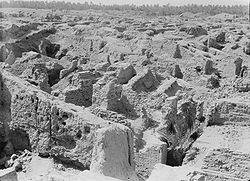Reconstructed Babylon -1
The earliest source to mention Babylon may be a dated tablet of the reign of Sargon of Akkad (ca. 24th century BC short chronology). The so-called "Weidner Chronicle" states that it was Sargon himself who built Babylon "in front of Akkad" (ABC 19:51). Another chronicle likewise states that Sargon "dug up the dirt of the pit of Babylon, and made a counterpart of Babylon next to Agade". Some scholars, including linguist I.J. Gelb, have suggested that the name Babil is an echo of an earlier city name. According to Dr. Ranajit Pal, this city was in the East[3]. Herzfeld wrote about Bawer in Iran, which was allegedly founded by Jamshid; the name Babil could be an echo of Bawer. David Rohl holds that the original Babylon is to be identified with Eridu. Some Biblical literalists believe that Nimrod was the original founder of Babel (Babylon), because this is stated in Book of Genesis 10. Joan Oates claims in her book Babylon that the rendering "Gateway of the gods" is no longer accepted by modern scholars.[citation needed] Over the years, the power and population of Babylon waned. From around the 20th century BC, it was occupied by Amorites, nomadic tribes from the west who were Semitic speakers like the Akkadians, but did not practice agriculture like them, preferring to herd sheep. The First Babylonian Dynasty was established by Sumu-abum, but the city-state controlled little surrounding territory until it became the capital of Hammurabi's empire (ca. 18th century BC). Hammurabi is known for codifying the laws of Babylonia into the Code of Hammurabi that was to have a profound influence on the region. From that time onward, the city continued to be the capital of the region known as Babylonia — although during the 440 years of domination by the Kassites (1595–1185 BC), the city was renamed Karanduniash. The city itself was built upon the Euphrates, and divided in equal parts along its left and right banks, with steep embankments to contain the river's seasonal floods. Babylon grew in extent and grandeur over time, but gradually became subject to the rule of Assyria. It has been estimated that Babylon was the largest city in the world from ca. 1770 to 1670 BC, and again between ca. 612 and 320 BC. It was perhaps the first city to reach a population above 200,000. It is recorded that Babylon's legal system developed a form of negligence law, and Babylon was probably the first culture to develop negligence law. In the common law world, the law of negligence was not fully rediscovered until the 20th century. During the reign of Sennacherib of Assyria, Babylonia was in a constant state of revolt, led by Mushezib-Marduk, and suppressed only by the complete destruction of the city of Babylon. In 689 BC, its walls, temples and palaces were razed, and the rubble was thrown into the Arakhtu, the sea bordering the earlier Babylon on the south. This act shocked the religious conscience of Mesopotamia; the subsequent murder of Sennacherib was held to be in expiation of it, and his successor Esarhaddon hastened to rebuild the old city, to receive there his crown, and make it his residence during part of the year. On his death, Babylonia was left to be governed by his elder son Shamash-shum-ukin, who eventually headed a revolt in 652 BC against his brother in Nineveh, Assurbanipal.
Once again, Babylon was besieged by the Assyrians and starved into surrender. Assurbanipal purified the city and celebrated a "service of reconciliation", but did not venture to "take the hands" of Bel. In the subsequent overthrow of the Assyrian Empire, the Babylonians saw another example of divine vengeance.| Diese Datei wurde ursprünglich bei Flickr hochgeladen. Sie wurde mit Hilfe von Flickr upload bot durch Dorieo hierher übertragen. Zu diesem Zeitpunkt – 25. September 2008, 18:08 – war sie bei Flickr unter der unten stehenden Lizenz freigegeben. |
- Dieses Werk darf von dir
- verbreitet werden – vervielfältigt, verbreitet und öffentlich zugänglich gemacht werden
- neu zusammengestellt werden – abgewandelt und bearbeitet werden
- Zu den folgenden Bedingungen:
- Namensnennung – Du musst angemessene Urheber- und Rechteangaben machen, einen Link zur Lizenz beifügen und angeben, ob Änderungen vorgenommen wurden. Diese Angaben dürfen in jeder angemessenen Art und Weise gemacht werden, allerdings nicht so, dass der Eindruck entsteht, der Lizenzgeber unterstütze gerade dich oder deine Nutzung besonders.
Relevante Bilder
Relevante Artikel
TreppeEine Treppe ist ein aus Stufen gebildeter Auf- oder Abgang, der es ermöglicht, Höhenunterschiede bequem und trittsicher zu überwinden. Das Verhältnis von Steigungshöhe zum Auftritt ist das (genormte) Steigungsverhältnis der Treppensteigung. .. weiterlesen
BabylonBabylon oder Babel war als Hauptstadt Babyloniens eine der wichtigsten Städte des Altertums. Sie lag am Euphrat, etwa 90 km südlich Bagdads im heutigen Irak. Die Ruinen der Stadt sind unter anderem von Robert Koldewey Anfang des 20. Jahrhunderts teilweise freigelegt worden. Der Ort war die Hauptstadt des gleichnamigen Stadtstaates, der zeitweise über weite Teile des südlichen Zweistromlandes sowie Gebiete westlich des Zweistromlandes herrschte. Die Blütezeit der antiken „Weltstadt“ Babylon lag zwischen 1800 und 140 v. Chr. Babylon/Babel diente in der westlichen Kulturgeschichte als Sinnbild von Hochmut und Niedergang („Sündenbabel“); diese Vorstellung geht auf die biblischen Berichte über die Stadt zurück. .. weiterlesen










































